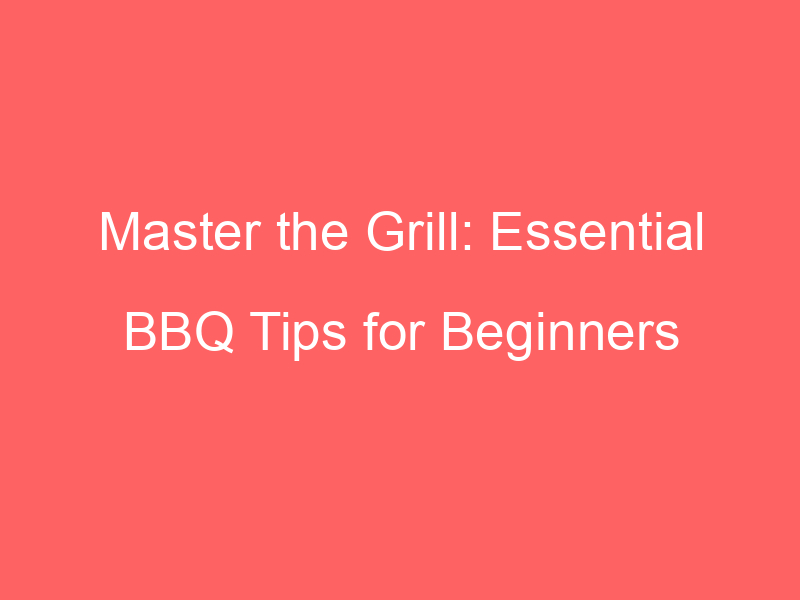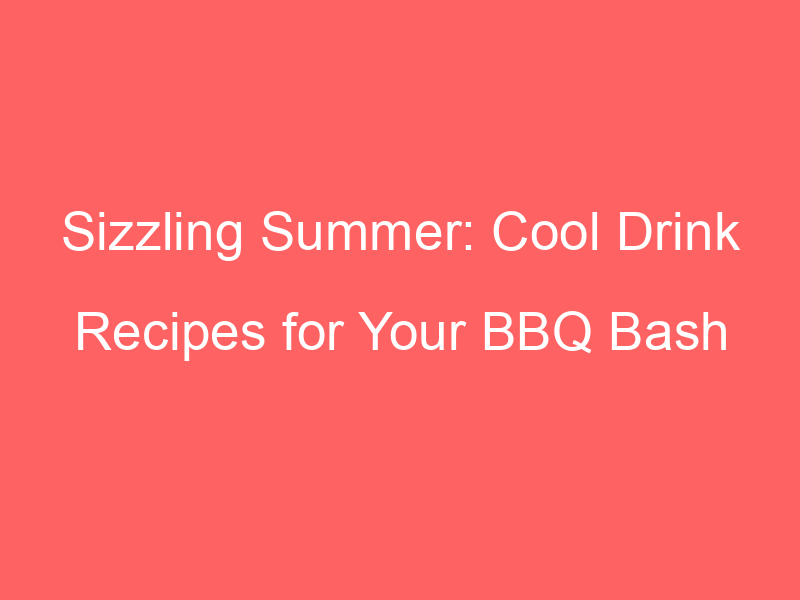Introduction to BBQ Grilling
Welcome to the exciting world of BBQ grilling! This is a culinary art that is loved by many, and for good reason. It’s not just about cooking food; it’s about the experience, the flavor, and the joy it brings to gatherings of family and friends. Whether you’re a seasoned griller or a beginner, there’s always something new to learn and discover in BBQ grilling.
- Understanding the basics of BBQ grilling
- Why BBQ grilling is a must-try for food enthusiasts
BBQ grilling is a cooking method that involves applying direct heat to food. It’s often done outdoors, using charcoal or gas grills. The food is typically placed on a grate above the heat source, allowing it to cook evenly. The basics of BBQ grilling include understanding how to control the heat, knowing when to flip your food, and mastering the art of seasoning. It’s also important to know the right cooking times for different types of food to ensure they’re cooked to perfection.
If you’re a food enthusiast, BBQ grilling is a must-try. It offers a unique flavor that’s hard to replicate with other cooking methods. The smoky, charred taste of grilled food is simply irresistible. Plus, it’s a fun and interactive way to cook. You can experiment with different types of food, marinades, and grilling techniques to create your own signature dishes. According to a survey, about 75% of U.S. adults own a grill or smoker. This shows how popular BBQ grilling is and why it’s a must-try for any food enthusiast.
So, are you ready to dive into the world of BBQ grilling? Stay tuned as we guide you through the basics, share tips for beginners, and explore different grilling techniques. Let’s get grilling!
BBQ for Beginners: Starting BBQ Grilling
Embarking on your BBQ grilling journey is an exciting adventure. One of the first steps is choosing the right grill. This decision can impact the flavor of your food, your grilling experience, and even the cost of your BBQ sessions. Let’s delve into the world of grills.
Choosing the Right Grill
There are two main types of grills: gas and charcoal. Each comes with its own set of advantages and disadvantages. Understanding these can help you make an informed decision.
- Gas vs. Charcoal: Pros and Cons
- Understanding Grill Sizes and Features
Gas grills are known for their convenience. They heat up quickly, are easy to clean, and offer precise temperature control. However, they are typically more expensive than charcoal grills and some BBQ enthusiasts argue that they don’t provide the same smoky flavor.
Charcoal grills, on the other hand, are celebrated for the distinct, smoky flavor they give to food. They are generally less expensive than gas grills but require more time to heat up and more effort to clean.
| Gas Grills | Charcoal Grills | |
|---|---|---|
| Pros | Quick heat-up, easy to clean, precise temperature control | Distinct smoky flavor, less expensive |
| Cons | More expensive, less smoky flavor | Longer heat-up time, more effort to clean |
Grill size should be determined by the number of people you typically cook for. A small grill is sufficient for a family of four, while a larger grill is better for parties or large gatherings.
Grill features can include side burners, storage cabinets, and even rotisseries. While these features can enhance your grilling experience, they also increase the cost. Therefore, consider your budget and grilling needs before deciding on these extras.
Remember, the best grill for you depends on your personal preferences, budget, and grilling needs. Happy grilling!
Essential Grilling Tools
When it comes to BBQ grilling, having the right tools can make all the difference. Let’s take a look at some of the essential grilling tools that every beginner should have.
-
Grill Tongs and Spatulas
Grill tongs and spatulas are like the hands of a grill master. Tongs are perfect for flipping and moving food around on the grill. They provide a secure grip and keep your hands safe from the heat. Spatulas, on the other hand, are great for flipping burgers and other flat foods. They have a wide surface that makes it easy to get under the food and flip it without causing it to fall apart.
-
Grill Brushes and Cleaning Tools
Keeping your grill clean is just as important as cooking the food. Grill brushes and cleaning tools help remove burnt food and grease from the grates, which can affect the taste of your food and cause flare-ups. It’s best to clean your grill after each use while it’s still warm. This makes it easier to remove the food particles and grease.
-
Heat-Resistant Gloves and Aprons
Grilling involves dealing with high heat and open flames, so it’s important to protect yourself. Heat-resistant gloves are essential for handling hot grill grates and tools. They provide a better grip and protect your hands from burns. An apron is also a good idea. It protects your clothes from food splatters and grease stains. Plus, wearing an apron makes you feel like a real grill master!
These are just a few of the essential tools for BBQ grilling. Having the right tools can make your grilling experience more enjoyable and help you cook delicious food. So, before you start grilling, make sure you have these tools on hand.
Grilling 101: BBQ Techniques for Beginners
Welcome to Grilling 101, where we will explore the basics of BBQ techniques for beginners. Whether you’re new to grilling or just want to improve your skills, this guide will provide you with the knowledge you need to grill like a pro.
Prepping the Grill
Before you start grilling, it’s essential to prepare your grill. This involves two main steps: proper cleaning and maintenance, and pre-heating the grill.
- Proper cleaning and maintenance
- Pre-heating the grill
Cleaning your grill is crucial to ensure it functions correctly and your food doesn’t stick to the grates. It’s best to clean your grill after each use, while it’s still warm. Use a grill brush to scrub off any food particles. Then, wipe it down with a damp cloth. Regular maintenance, such as checking for rust and replacing worn-out parts, will extend the life of your grill.
Pre-heating your grill is just as important as pre-heating an oven. It ensures your food cooks evenly and helps to sear the outside, locking in flavor. To pre-heat your grill, light it and let it heat up for about 15 minutes before adding your food. The temperature you need will depend on what you’re cooking, but a good rule of thumb is to aim for between 400 and 450 degrees Fahrenheit for most foods.
Remember, a well-prepared grill is the first step to a successful BBQ. With these simple steps, you’ll be ready to start grilling in no time.
Mastering Heat Control
When it comes to BBQ grilling, mastering heat control is crucial. It’s the key to cooking your food evenly and preventing it from getting burnt. Let’s dive into two important aspects of heat control: understanding direct and indirect heat, and managing flare-ups.
- Understanding Direct and Indirect Heat
- Managing Flare-Ups
Direct heat is when you cook your food directly over the heat source. This is great for searing meat and cooking food quickly. However, it’s also easy to burn your food if you’re not careful.
Indirect heat, on the other hand, is when you cook your food away from the heat source. This is perfect for slow-cooking food and ensuring it’s cooked thoroughly without burning the outside. It’s like turning your grill into an oven!
Knowing when to use direct or indirect heat can make a huge difference in your grilling. For example, steaks and burgers are best cooked over direct heat, while larger cuts of meat like a whole chicken or a pork shoulder benefit from indirect heat.
Flare-ups are sudden bursts of flame that can occur when fat drips onto the heat source. They can cause your food to burn and create a smoky flavor. While a little bit of smoke can add a nice flavor to your food, too much can make it taste bitter.
There are several ways to manage flare-ups. One way is to keep a spray bottle of water nearby to douse any sudden flames. Another is to move your food away from the flare-up until it dies down. You can also prevent flare-ups by trimming excess fat from your meat before grilling and keeping your grill clean.
In conclusion, mastering heat control is all about understanding how to use direct and indirect heat, and knowing how to manage flare-ups. With these skills, you’ll be well on your way to becoming a BBQ grilling pro!
BBQ Grilling Essentials: Cooking Techniques
Mastering the art of barbecue grilling is not just about having the right tools, but also about knowing the best cooking techniques. Let’s delve into the different types of food you can grill and the best ways to do it.
Grilling Different Types of Food
When it comes to grilling, the possibilities are endless. From juicy meats to fresh vegetables and even fruits, your grill can handle it all. Here are some essential tips for grilling different types of food:
- Grilling meats: steaks, burgers, and sausages
- Grilling vegetables and fruits
Grilling meats is a classic BBQ favorite. For steaks, it’s all about the sear. Preheat your grill to high and sear each side for 1-2 minutes. Then, reduce the heat and continue cooking to your desired doneness. Burgers and sausages require medium heat. Remember to turn them frequently for even cooking. A digital meat thermometer is a handy tool to ensure your meat is cooked to the right temperature.
Vegetables and fruits can add a delightful twist to your BBQ menu. For vegetables, cut them into uniform pieces to ensure even cooking. Most vegetables grill well at medium heat. As for fruits, choose firm ones like apples, peaches, or pineapples. Grill them over low heat until they are tender and slightly caramelized.
Remember, practice makes perfect. The more you grill, the better you’ll get at knowing when your food is cooked just right. So, fire up that grill and start practicing these techniques today!
Marinating and Seasoning
One of the most critical aspects of BBQ grilling is the art of marinating and seasoning. This process can transform a simple piece of meat into a flavorful masterpiece. Let’s delve into the details of choosing the right marinades and rubs and timing your marinades for optimal flavor.
- Choosing the Right Marinades and Rubs
- Timing Your Marinades for Optimal Flavor
Choosing the right marinades and rubs can make a world of difference in your BBQ grilling experience. Marinades are liquid mixtures, often made of oil, vinegar, and spices, that tenderize and flavor the meat. Rubs, on the other hand, are dry mixtures of spices and herbs applied to the meat’s surface.
When choosing a marinade or rub, consider the type of meat you’re grilling. For instance, a citrus-based marinade works well with chicken, while a spicy rub can enhance the flavor of beef. Experiment with different combinations to find what suits your taste buds best.
Timing is crucial when it comes to marinating. Too little time, and the flavors won’t penetrate the meat. Too much time, and the meat may become mushy. As a general rule, most meats should be marinated for at least 2 hours, but no more than 24 hours. However, delicate meats like fish require a shorter marinating time, usually no more than 30 minutes.
Remember, the goal of marinating is to enhance the flavor of your BBQ, not overpower it. So, be mindful of the time and let the natural taste of the meat shine through.
In conclusion, marinating and seasoning are essential steps in BBQ grilling. By choosing the right marinades and rubs and timing your marinades correctly, you can elevate your BBQ to new flavor heights. Happy grilling!
First Time BBQ Tips: Avoiding Common Mistakes
When you’re just starting out with BBQ grilling, it’s easy to make a few mistakes. But don’t worry, we’re here to help you avoid them. One of the most common mistakes made by first-time grillers is either overcooking or undercooking the food. Let’s dive into how you can prevent these issues.
Overcooking and Undercooking
Overcooking and undercooking are two common mistakes that can ruin your BBQ. Overcooked food can be tough and dry, while undercooked food can be a health risk. Here are two tips to help you avoid these pitfalls:
- Using a meat thermometer:
- Understanding cooking times for different foods:
One of the best ways to ensure your meat is cooked to perfection is by using a meat thermometer. This handy tool can take the guesswork out of grilling and provide you with accurate readings of the internal temperature of your meat. For example, chicken should reach an internal temperature of 165°F (74°C) to be safe to eat, while steaks are typically done at 145°F (63°C).
Different foods require different cooking times. For instance, a thick steak will take longer to cook than a thin chicken breast. It’s important to understand these differences to avoid overcooking or undercooking your food. Here’s a simple table to guide you:
| Food | Cooking Time |
|---|---|
| Chicken breast | 15-20 minutes |
| Steak (1 inch thick) | 10-15 minutes per side |
| Shrimp | 2-3 minutes per side |
By using a meat thermometer and understanding the cooking times for different foods, you can avoid the common mistakes of overcooking and undercooking. Remember, practice makes perfect. So, don’t be discouraged if your first few attempts aren’t perfect. Keep trying, and you’ll soon be a BBQ pro!
Food Safety
When it comes to BBQ grilling, food safety is a top priority. It’s not just about the taste of your food, but also about keeping everyone healthy. Let’s explore some key aspects of food safety.
- Proper Food Handling and Storage
- Ensuring Your Grill is Safe to Use
Proper food handling is essential to prevent foodborne illnesses. Always wash your hands before and after handling food. Use separate cutting boards for raw and cooked foods to avoid cross-contamination. When it comes to storage, refrigerate or freeze perishable food within two hours of purchasing or preparing it. Keep your refrigerator temperature below 40°F and your freezer at 0°F. Remember, when in doubt, throw it out!
Before you start grilling, make sure your grill is safe to use. Check for any damage or rust, especially in the gas line if you’re using a gas grill. Clean your grill regularly to prevent grease buildup, which can cause fires. Always keep a fire extinguisher nearby when you’re grilling. And remember, never leave your grill unattended when it’s in use.
By following these food safety tips, you can ensure that your BBQ grilling experience is not only delicious but also safe. So, fire up that grill and enjoy!
Conclusion: The Joy of BBQ Grilling
As we conclude this comprehensive guide to BBQ grilling, it’s important to reflect on the journey we’ve taken. From understanding the basics of BBQ grilling to learning about the various techniques and avoiding common mistakes, we’ve covered a lot of ground. But the joy of BBQ grilling lies not just in the delicious food you create, but also in the process of learning and mastering this art.
- Reflecting on the beginner’s guide to BBQ
- Encouraging continuous learning and practice
We started our journey with an introduction to BBQ grilling, exploring the basics and setting the foundation for your BBQ grilling adventure. We then moved on to the essentials of BBQ grilling, where we discussed various cooking techniques that can elevate your grilling game. We also shared some valuable tips for first-time grillers to help you avoid common mistakes and ensure a smooth grilling experience.
Remember, the key to mastering BBQ grilling is continuous learning and practice. Don’t be disheartened if your first few attempts don’t turn out as expected. Keep experimenting with different techniques, try out new recipes, and most importantly, have fun in the process. As the saying goes, “The only real stumbling block is fear of failure. In cooking, you’ve got to have a what-the-hell attitude.” – Julia Child.
So, go ahead and embrace the joy of BBQ grilling. It’s not just about cooking food, it’s about creating memories, sharing good times, and experiencing the satisfaction of creating something delicious from scratch. Happy grilling!






